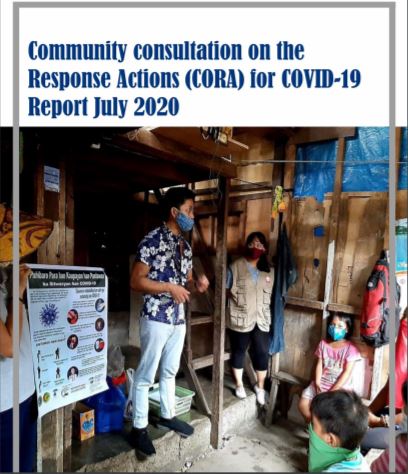Community consultation on the Response Action (CORA) for COVID-19
Cover Message
The conduct of Community consultation on the Response Action (CORA) for COVID-19 last June 2020 was crucial in validating how responding agencies from the government and other organizations are able to maximize preferred platforms of the at-risk communities in the provision of life-saving and other forms of aid, getting feedback on the support received by the people in need and addressing those feedback or concerns through trusted channels and inclusive mechanisms in the affected areas.
CORA is one form of community engagement that is embedded in the holistic approach of the Humanitarian Country Team’s Humanitarian Response Plan (HCT’s HRP) on COVID-19. The conduct of CORA was necessary to ensure that the humanitarian response is more accountable, inclusive, and enabling. The collective initiative supports enhancing community participation and improving the overall quality of the humanitarian intervention programming. The process includes utilizing communication mechanisms, accountability frameworks and community participation channels to advance the people-driven response, safeguard the humanitarian principles and turn post-pandemic adversity into opportunities that will help better understand gender-age-disability sensitive vulnerabilities; enhance local resilience or adaptive capacity under the new normal; encourage meaningful participation and emphasize equity of affected communities.
- Food remains the top priority needs of the affected communities.
- Providing alternative livelihood opportunities is one of the supports expected by the affected communities from the government.
- Under the new normal, many respondents believe that physical and social distancing will continue up to the end of the year or it can be extended up to next year.
- Wearing facemask is not just a health protocol anymore but rather a way of life under the new normal.
- Some local organizations are providing community tutorials to children with less access to online learning.
- Despite of the lockdown, Bayanihan” spirit (sense of belongingness) is still alive within the community.
- Some respondents said that an in-depth follow-up consultation may be needed to monitor if the existing protection mechanism is effective, helpful and accessible.
- COVID-19’s socio-economic impact deepens the inequities for the vulnerable groups such as persons with disabilities and elderlies.
- Parents consulted believe that online education system will not work for public students unless access to online learning will be subsidized by the government.
Area coverage: Identified at-risk or affected areas across the country.
- Bangsamoro Autonomous Region of Muslim Mindanao (BARMM)
- Bicol Region
- Caraga Region
- Cavite-Laguna-Batangas-Rizal-Quezon (CALABARZON)
- Central Luzon
- Central Visayas
- Cordillera Administrative Region (CAR)
- Davao Region
- Eastern Visayas Region
- Ilocos Region
- Mindoro-Marinduque-Romblon-Palawan Region (MIMAROPA)
- Mountain Province
- National Capital Region (NCR)
- Northern Mindanao
- South Cotabato-Cotabato-Sultan Kudarat-Sarangani-General Santos Region (SOCCSKSARGEN)
- Western Visayas
- Zamboanga Peninsula
Agencies involved: CoPCE members from UN agencies, International Non-Government Organizations (INGOs), Civil Society Organizations (CSOs), Faith-Based Groups (FBGs), People’s Organizations (POs), Community Organizations (Cos) and local governments.
- Assistance and Cooperation for Community Resilience and Development, Inc (ACCORD)
- ACTED
- Action Against Hunger
- Bidlisiw Foundation
- Care-Philippines
- Caritas-Germany
- ChristofelBlindenmission International (CBM International)
- Community and Family Services International (CFSI)
- Caucus of Development Non-Government Organizations networks (CODE-NGO)
- Coalition of Services of the Elderly (COSE)
- Disaster Risk Reduction-Network (DRRNet)
- Far Eastern Broadcasting Compant (FEBC)
- FundacionEducacion y Cooperacion (EDUCO-Philippines)
- Ground Truth Solutions (GTS)
- Humanity and Inclusion (HI)
- Integrated Resource Development for Tri-people (IRDT)
- Mother of Hope Children Center (MHCC)
- National Council of the Churches in the Philippines (NCCP)
- National Secretariat for Social Action Center (NASSA)
- Office for Coordination of the Humanitarian Affairs (OCHA)
- Plan International
- Shared Aid Funds for Emergency Response (SAFER)
- Sumpay Mindanao, Inc.
- TiyakapKalilintad (TKI)
- The Moropreneur, Inc. (TMI)
- United Nation Children’s Fund (UNICEF)
- United Nations High Commissioner for Refugees (UNHCR)
- World Health Organization (WHO)
- World Vision Philippines
On humanitarian aid preferences and priorities
With limited access to financial support and other livelihood opportunities, undeniably, the affected communities’ capacity and efforts to recover and rebuild their lives once the pandemic is declared over are restricted. COVID-19 exacerbates their vulnerability as it forces them to make desperate decisions or measures just to survive. For at-risk communities, unclear implementation of COVID-19 lockdown, community quarantine, and overall response to recovery plan simply mean extending uncertainties to their survival and prolonging their current woeful conditions.
On information needs, preferred communication channels and accountability mechanisms
Shutting down of the country’s largest broadcast network (ABS-CBN) by the Philippines Congress becomes not only a threat to the country’s press freedom but a big blow to at-risk communities’ access to life-saving information and crucial updates. The impact greatly affects those who do not have access to online platforms such as social media and even those who, despite being highly dependent getting information from local officials, friends, relatives and neighbors, are also getting more information through TV and radio. The largest broadcast network is being considered too as a means, through its TV and radio frequencies, to provide alternative learning modalities to affected students. Crucial in the time of the pandemic is provision of more credible, vibrant, independent and alternative source of information to people at risk to enable them to know what is really going on and provide the necessary feedback to government’s action in responding to their needs.
On Socio-Behavior Consideration
Many of the respondents believed that they have no choice but to adapt to the restrictions and routine of the new normal. The same goes with drastically shifting their priorities over the next coming months. The toughest act for the most affected and vulnerable communities would be to live and work under circumstances where the country’s economy is still reeling from the losses, government is struggling to respond on the affected population’s evolving needs, vaccine has yet to be found, and livelihood opportunities are limited.
On Socio-Economic Factor
Over the last five months, most respondents ranked less livelihood opportunities (70percent), financial instability (62 percent), loss of education (49 percent), affecting more vulnerable and marginalized groups (30 percent) and increased vulnerability for members of the family (28 percent) as the top five socio-economic impacts to them since the lockdown began. Others highlighted that overall community (16 percent) as well as domestic/family relationships (16 percent) were somewhat strained due to lockdown and less access to essential services.
On Protection Issues
Overall social and economic disruptions due to COVID-19 pandemic have amplified the risks and vulnerability of children and women to domestic violence, exploitation and abuse. These further weakened the support that the affected communities need as lockdown and community quarantine limit, if not hinder, inclusive access to a system or platform that would protect them. Stressing violations and gaps on any protection measures have been crucial in the conduct of CORA considering the alarming reported cases of gender-based abuse and violence before and during the lockdown.
On Access to Health Services
The lifting of lockdown and quarantine restriction in some areas increases the likelihood of large-scale local transmission. As big health facilities and major hospitals are beginning to be overwhelmed by the large number of confirmed positive cases, community transmission on mobile communities or those areas that are now under modified community quarantine has started to become widespread. The overall Philippine government’s COVID-19 response enters the crunch time to operationalize a collective strategy in addressing surge capacity and looming large-scale transmission across at-risk areas in the country. To know more about CORA, please see attached document.

Cover message is on behalf of Gil Francis Arevalo (Operational Readiness and Response Unit) OCHA.
